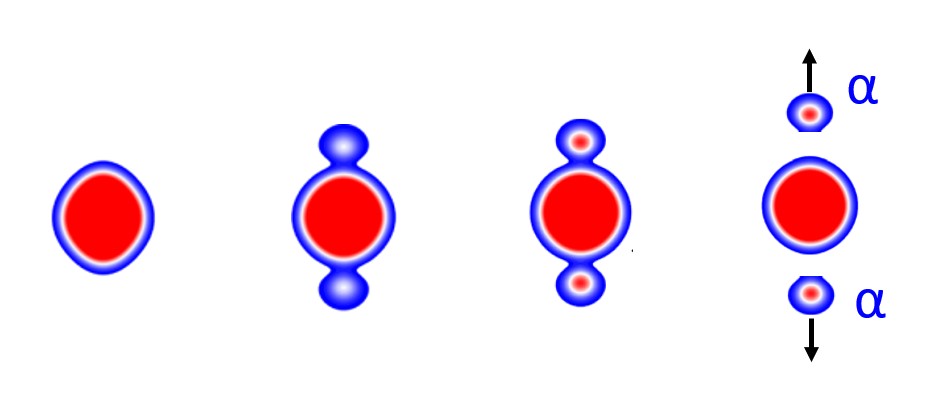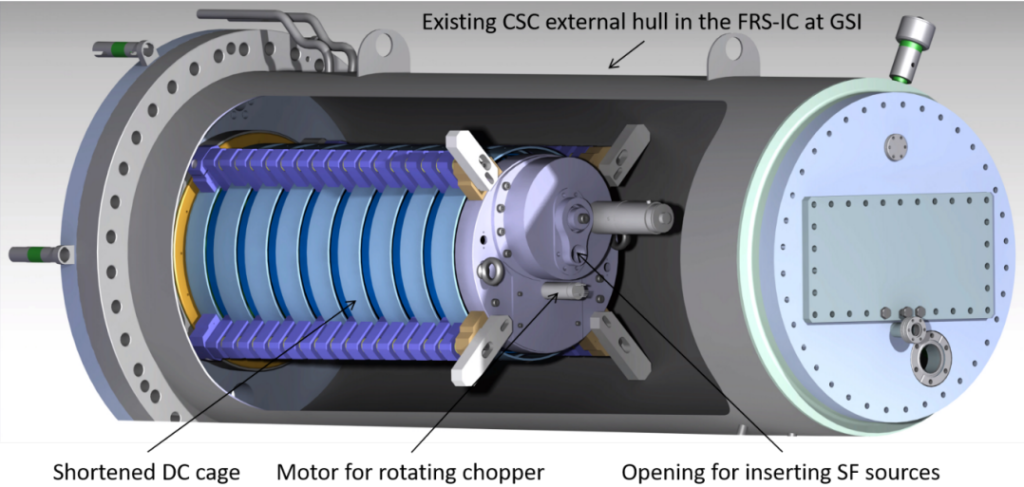Spontaneous Fission
A direct method to measure fission product yield distributions (FPY) and isomeric yield ratios (IYR) for spontaneous fission (SF) fragments can be implemented with the FRS Ion Catcher. These physical properties are of utmost importance to the understanding of basic nuclear physics, the astrophysical rapid neutron capture process (‘r process’) of nucleosynthesis, neutron star composition and nuclear reactor safety. With this method, fission fragments are produced by spontaneous fission from a source that is mounted in the cryogenic stopping cell (CSC), thermalized and stopped within it and then extracted and transported to a multiple-reflection time-of-flight mass-spectrometer (MR-TOF-MS) to separate and identify by mass all isobars and numerous isomers in the fission fragment realm. The system’s essential element independence and its fast simultaneous mass measurement provide a new direct way to measure isotopic FPY distributions, which is complementary to existing methods. It will enable nuclide FPY measurements in the high fission peak, which is hardly accessible by current techniques. The extraction time of the CSC, tens of milliseconds, enables a direct measurement of independent fission yields, and a first study of the temporal dependence of FPY distributions in this duration range. The ability to resolve isomers will further enable direct extraction of numerous IYRs while performing the FPY measurements.
The method has been recently demonstrated at the FRS Ion Catcher for with a 37 kBq ^{252}Cf fission source, where about 70 different fission fragments have been identified and counted. In the near future, it will be used for systematic studies of SF with a higher-activity ^{252}Cf source and a ^{248}Cm source. This method can be implemented also for neutron induced fission at appropriate facilities.
Double Alpha Decay
Double-alpha decay is a predicted nuclear decay mode where the nucleus emits two 𝛼-particles simultaneously. This process was first considered in the 1980s as a sequence of ^{8}Be-cluster emission followed by its disintegration. According to a recent study [F. Mercier et al., PRL 127, 012501 (2021)], immediate double-alpha decay for ^{224}Ra is more likely to occur than ^{8}Be-like cluster decay by more than 13 orders of magnitude, and it might be detected as a back-to-back emission of two 𝛼-particles.

To verify the prediction, an offline experiment was conducted at the FRS Ion Catcher in 2022. A ^{228}Th source was mounted into the Cryogenic Stopping Cell and used for production of ^{224}Ra ions. These ions were extracted, selected, focused with an ions optic system and implanted on a thin carbon foil. Two double-sided silicon strip detectors (DSSDs) located around the foil registered the energy, time, and spatial position of 𝛼-particles emitted by the implanted ions.

The experiment lasted about half a year. The longest data acquisition run, during which a pure ^{224}Ra^{2+} beam had been produced, took as much as 80 days. The expected number of detected double-alpha decays is about 100 whereas the total number of implanted ions is estimated to be about 3·10^{9}. Presently, the data obtained is being analysed. Key factors of DSSD calibration such as detector geometry, energy and time resolution are under investigation and a publication is in process. Once it is completed, the data will be unblinded, and a final comparison with background simulation will be carried out. This final stage of the analysis will allow to claim confirmation of the existence of a new decay or to set a lower limit on the half-life of double-alpha decay.

